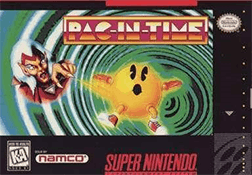Pac-In-Time
| Pac-In-Time | |
|---|---|
|
Cover art for the Super NES version | |
| Developer(s) | Kalisto |
| Publisher(s) | Namco |
| Composer(s) | Frédéric Motte |
| Platform(s) | Super NES, Game Boy, MS-DOS, Mac OS |
| Release date(s) | |
| Genre(s) | Platform |
| Mode(s) | Single-player, Two player |
Pac-In-Time (パックインタイム) is a video game developed by Kalisto and published by Namco, featuring the popular arcade character Pac-Man. It was released in 1994 for MS-DOS, Macintosh, Super NES and Game Boy. It was released shortly after Pac-Man 2: The New Adventures, which brought about the change from the classic arcade versions of Pac-Man to the development of more complex and adventurous games.
This game was an offshoot from the normal variety of Pac-Man games, in that it does not confine Pac-Man to a maze-like board. Rather, the player controls Pac-Man through various side-scrolling levels, obtaining many different items along the way; the plot does take elements from the earlier Pac-Man games, such as the objective to collect a certain number of pellets before exiting a level. The game allows the player to access completed levels via passwords that are given every five levels.
The game is a rebranded version of a 1993 game, Fury of the Furries, also developed by Kalisto. The PC, Macintosh and Game Boy versions are almost identical to the original, while the Super NES game, despite using the same basic gameplay mechanics, is an entirely new game using a different game engine and aesthetic.
Versions of Pac-In-Time for the Genesis and Game Gear were planned, but canceled. A ROM image of the Game Gear version has since surfaced online.
Plot
Pac-Man's nemesis, the Ghost Witch, has cast a spell on Pac-Man that has transported him back in time to the days of his youth in the year 1975 (5 years before the debut of the original arcade game). By fighting through snowy mountains and forests, swimming through water and swinging through trees, collecting fireballs and bubbles and facing enemies such as bats and ghosts, he must find his way back to his present day.
Gameplay
The player controls Pac-Man as he must find his way through five different worlds, each with 10 different levels. Each level contains about 30 different Pac-Pellets that must be found in order to complete it. The end of the level is marked with a door that is only opened once all of the required pellets have been collected. Along the way, Pac-Man will run into many enemies — most of which are just native to the environment of the level, such as bats, birds, rats, worms, carnivorous plants, ram-like creatures, etc. Pac-Man also runs across his long-time enemies, the ghosts, who appear frequently in every level and chase after Pac-Man. Fortunately, there are Power Pellets along the way, and Pac-Man can use these to devour the ghosts in his typical fashion.
Unique to this game, Pac-Man can also acquire four different abilities that will help him finish his quest and defeat his enemies. Each of these abilities can be obtained by jumping through one of four different colored rings. Although Pac-Man can hold all four abilities at once, he can only use one at a time by rotating between them. This game style was used in Kalisto's earlier game Fury of the Furries.
There are many other items that help Pac-Man out in his quest. He can find many food items that replenish portions of his health, as well as extra lives along the way. There are also the Power Pellets to use when there are approaching ghosts. Certain elements and levels vary slightly from system to system.
Reception
| Reception | ||||||||
|---|---|---|---|---|---|---|---|---|
| ||||||||
Covering the Super NES version, the four reviewers of Electronic Gaming Monthly praised the graphics, play control, general cuteness, and fun gameplay, though they remarked that the game gets extremely hard towards the end.[1] GamePro gave it a positive review as well, similarly complimenting the graphics, control, and gameplay. They particularly praised both Pac-Man's new moves and the revival of moves from the original Pac-Man, saying that together they "breathed new life into a classic character."[3] A reviewer for Next Generation approved of the graphics, controls, and gameplay, emphasizing that Pac-Man's many skills in the game results in levels which are "like action puzzles". He concluded that the game's only weakness is the limited variation between the levels.[2]
References
- 1 2 "Review Crew: Pac-In-Time". Electronic Gaming Monthly. Sendai Publishing (68): 34. March 1995.
- 1 2 "Pac-In-Time". Next Generation. Imagine Media (6): 113–4. June 1995.
- ↑ "ProReview: Pac-In-Time". GamePro. IDG (79): 66. April 1995.
